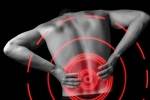Home »
Blog » Back Pain
| Stem Cell, PRP, Acupuncture in Queens & Long Island, New York
Back Pain | Stem Cell, PRP, Acupuncture in Queens & Long Island, New York
Tags: Back Pain | Posted on: 10-Jan-2022 | No of views: 3497 Pain is one of a series of sensory systems in the human body, including the visual system (sight), the auditory system (hearing), the olfactory system (smell), the gustatory system (taste), and the somatosensory system (touch). While many consider pain to be a part of the somatosensory system/touch system, actually pain has its own dedicated pathways in the body and spinal cord, as well as its own unique areas in the brain. This makes sense when you think of what the purpose of the pain system is.
Read more
Tags: Back Pain | Posted on: 07-Jan-2022 | No of views: 3769 Engaging in a routine yoga program targeted to treat scoliosis may help reduce the severity, correct your spinal posture, and/or improve balance. To help you kickstart a yoga routine, here are 4 easy yoga poses that you can try at home with a yoga mat or a thick towel. It is important to start slow and easy, and as with any exercise, always check with your doctor or therapist first.
1. Mountain Pose - This is a great pose for beginning your yoga practice. It helps with balance and core strength, and it is a pose that requires you to stand tall and steady, like a mountain.
Read more
Tags: Back Pain | Posted on: 05-Jan-2022 | No of views: 4053 Set Yourself Up for Success - Although you may be able to get your work done at a cramped desk, in poor light, or while you peer at a far-away computer screen, none of these things is great for your body. When you hold yourself in awkward positions, you may get problems with your muscles, tendons, ligaments, or nerves. If you already have a condition like arthritis or diabetes, you may be at higher odds of that happening.
Read more
Tags: Back Pain | Posted on: 31-Dec-2021 | No of views: 3281 A strong and supple spine can help make your activities of daily life more comfortable and less painful. Take time to treat your spine to several of these 11 indulgences and make your favorite ones a part of your everyday routine:
1. Make Exercise A Lifestyle - Exercise is essential when it comes to maintaining a healthy spine and it can also aid in the rehabilitation of an injured spine.
Read more
Tags: Back Pain | Posted on: 20-Dec-2021 | No of views: 3705 The importance of journaling is mostly underrated. Learn more about journaling and how it can be used to assist in managing chronic pain.
What is Journaling? Journaling is one method you can use to take stock of your thoughts and feelings. This usually comes with the intention of working through them in a positive direction. Like meditation, it is a mindfulness-oriented intervention. When used correctly, it can be a therapeutic treatment that fosters awareness and acceptance.
Read more
Tags: Back Pain | Posted on: 15-Dec-2021 | No of views: 5368 When You Ache All Over - Muscle pain that affects a small part of your body is usually caused by overuse -- sore arms from lifting boxes all day, for example. Or it could be a minor injury, like a bruised shoulder after a fall. But when you ache all over your body, it’s more likely caused by an infection, illness, or medicine you’ve taken.
Read more
Tags: Back Pain | Posted on: 29-Nov-2021 | No of views: 3748 Talking about and explaining chronic pain is extremely difficult for most. Here are some tips on how to make the conversation easier. A broken leg in the cast automatically triggers sympathetic glances and supportive actions. People rush plump pillows, fetch a glass of water, and do anything else they can do to help the poor fellow with the broken leg. There is no doubt in their mind about the pain he is experiencing.
Read more
Tags: Back Pain | Posted on: 27-Nov-2021 | No of views: 3440 While back pain is exceedingly common, it is equally challenging to diagnose, since there is no established guideline or protocol to evaluate this problem. Besides, the typical setting of a 15-minute doctor’s visit is usually not enough to explain, understand, and evaluate everything that’s going on in your achy back. Diagnosing the root cause of back pain requires time, physician expertise, and collaboration between different medical professionals, such as primary care doctors, physical therapists, physiatrists, and orthopedic physicians, to name a few.
Read more
Tags: Back Pain | Posted on: 19-Nov-2021 | No of views: 3934 While an adjustable bed may help alleviate your back pain, they’re not for everyone. Here are 3 questions to help you decide if an adjustable bed is worth your hard-earned money. 1. Do You Feel Better in A Reclined Position? As a general rule, people who find relief from back pain while in a reclined position tend to benefit from sleeping in an adjustable bed.
Read more
Tags: Back Pain | Posted on: 15-Nov-2021 | No of views: 3318 Pain beliefs are a major factor that affects how we experience pain. It can work both for us, and against us! The way we perceive each situation determines how we feel. Our perceptions are strongly influenced by beliefs we develop by thinking the same thoughts repeatedly. Healthy habits of thought result in more positive emotions, less stress, and less pain. Unhealthy habits of thought result in more negative emotions, more stress, and more pain.
Read more
Love this Post? Spread the World






















